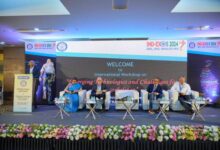Akamai Releases First Quarter 2015 ‘State of the Internet’ Report

- Global average connection speed increased 10% to 5.0 Mbps; South Korea leads at 23.6 Mbps
- United Kingdom had the fastest average mobile connection speed at 20.4 Mbps, a 28% quarterly increase
- 1.2% quarterly increase in unique IPv4 addresses to more than 812 million
Akamai Technologies, Inc. (NASDAQ: AKAM), the global leader in content delivery network (CDN) services, today released its First Quarter, 2015 State of the Internet Report. Based on data gathered from the Akamai Intelligent Platform, the report provides insight into key global statistics such as connection speeds, broadband adoption across fixed and mobile networks, and IPv4 exhaustion and IPv6 implementation.
Beginning this quarter, security-related content that was previously included in the State of the Internet Report, including data on attack traffic seen across the Akamai platform and insights into high-profile security vulnerabilities and attacks, is now published in a separate State of the Internet / Security Report.
Data and graphics from the First Quarter, 2015 State of the Internet Report can be found on the Akamai State of the Internet site and through the Akamai State of the Internet app for iOS and Android devices. State of the Internet Report-related discussions are also taking place on the Akamai Community.
“We saw generally positive results across all of the key metrics during the first quarter of 2015,” said David Belson, editor of the report. “The increase in global broadband speeds demonstrates an ongoing commitment to higher standards. While connectivity will continue to differ across many regions, we see the highest broadband speeds in countries/regions with high population densities and strong government backing or support, as well as those that foster competition among Internet providers.”
Global Average Connection Speeds and Global Broadband Connectivity
In the first quarter of 2015, the global average connection speed for the first time reached 5 Mbps, a 10% increase over the previous quarter. Quarterly global average connection speeds among the top 10 countries all remained well above 10 Mbps, and six of the 10 had average speeds above 15 Mbps, as Ireland (17.4 Mbps), Sweden (15.8 Mbps) and the Netherlands (15.3 Mbps) joined South Korea (23.6 Mbps), Hong Kong (16.7 Mbps) and Japan (15.2 Mbps) in exceeding this benchmark in the first quarter. Globally, a total of 131 qualifying countries/regions saw average connection speeds increase in the first quarter, with growth rates ranging from 128% in Fiji (6.2 Mbps) to a modest 0.4% in Japan (15.2 Mbps). Year-over-year changes were consistently positive among the top 10, with Ireland (17.4 Mbps), Norway (14.1 Mbps) and Sweden (15.8 Mbps) all posting yearly increases of more than 30%.
In the first quarter, global average peak connection speeds increased 8.2% to 29.1 Mbps. Speeds increased across the board among countries/regions in the top 10, led by Kuwait (76.5 Mbps) and Mongolia (68.9 Mbps) with impressive gains of 126% and 72%, respectively. Singapore (98.5 Mbps) rose 17% to overtake Hong Kong as the country/region with the highest average peak connection speed. All of the top 10 countries/regions saw average peak speeds greater than 65 Mbps. On a global basis, 124 out of 144 qualifying countries/regions experienced average peak connection speed increases from the fourth quarter, with growth ranging from 0.2% in Puerto Rico (41.2 Mbps) to 126% in Kuwait (76.5 Mbps). Average peak connection speeds in 136 countries/regions increased from the first quarter of 2014.
For the first time, the State of the Internet is reporting on the percentage of IP addresses connecting to Akamai at average speeds of above 25 Mbps, the new benchmark broadband speed adopted by the U.S. Federal Communications Commission in January 2015. Globally, 4.6% of unique IP addresses connected to Akamai at average connection speeds of at least 25 Mbps, a 12% increase over the previous quarter. Similar to the 10 Mbps and 15 Mbps metrics, South Korea led the world in 25 Mbps broadband adoption, with a 31% adoption rate. Its rate was nearly double that of second-place Hong Kong (17% adoption). Year-over-year, the global 25 Mbps adoption rate grew 20%, and all of the top 10 countries/regions posted gains except South Korea, which saw a 5.9% decline compared with the first quarter of 2014. In the United States, five states had 10% or more of unique IP addresses connect to Akamai at average speeds of at least 25 Mbps.
The global percentage of unique IP addresses connecting to Akamai that met the 4 Mbps broadband speed threshold increased 6.6% to 63%, revealing strength across the board in contrast to the previous quarter’s slight decline in this metric. Globally, 107 countries/regions qualified for inclusion for this metric, and 100 of them saw quarterly growth in 4 Mbps broadband adoption rates, up from 76 in the previous quarter. Year-over-year growth rates ranged from 0.1% in Jamaica (43% adoption) to 1,402% in Algeria (3.3% adoption).
In the first quarter of 2015, 26% of unique IP addresses globally connected to Akamai at average speeds above 10 Mbps, an 11% quarterly increase that is significantly greater than the previous quarter’s modest 2.9% gain. Seven of the top 10 countries/regions saw quarter-over-quarter increases, ranging from 3.9% in Switzerland (59% adoption) to 21% in Bulgaria (55% adoption). Among the 68 qualifying countries/regions, 60 saw quarter-over-quarter increases. In terms of year-over-year changes, there was a 27% increase globally in the percentage of unique IP addresses connecting to Akamai at average speeds above 10 Mbps.
Fourteen percent of unique IP addresses globally connected to Akamai at average connection speeds of 15 Mbps or above, up from 12% in the fourth quarter. Despite declining for the second quarter in a row, South Korea remained the clear leader in 15 Mbps broadband adoption with a 58% adoption rate after a 4.9% quarterly decrease. Overall, quarterly gains were seen in 46 qualifying regions/countries, compared with only 35 in the previous quarter. Year-over-year, the global 15 Mbps adoption rate grew 29% with strong gains among all of the top 10, except in South Korea, which had a 4.2% decline compared with the first quarter of 2014.









